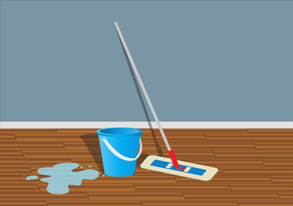Archives
Thriving with COPD
 Russell Winwood was stunned when, in 2011, he was diagnosed with Stage 4 chronic obstructive pulmonary disease (COPD). He was only 45. He was fit and active — and had already signed up to compete in the grueling Australian Ironman.
Russell Winwood was stunned when, in 2011, he was diagnosed with Stage 4 chronic obstructive pulmonary disease (COPD). He was only 45. He was fit and active — and had already signed up to compete in the grueling Australian Ironman.
Winwood refused to let the illness slow him down. Eight months after his diagnosis, the Australia native finished the Ironman competition, comprised of a 2.4-mile swim, 112-mile bicycle ride and a marathon.
“My respiratory specialist told me I wouldn’t finish it, but that made me more determined to complete the event,” Winwood said in an interview with healthline.com.
Winwood hasn’t stopped. Despite suffering a stroke and working with just 22%-30% of his lung capacity, Winwood has competed in several marathons and triathlons since his diagnosis. That includes the famed New York City Marathon — making him the first person with Stage 4 COPD to do so. Winwood accomplished the feat in 2015 and raised $10,000 for the American Lung Association while doing it.
“A lot of people are skeptical of how I can do what I do, as people with my stage of disease don’t do Ironman events or run marathons,” Winwood said. “But the truth is that a healthy lifestyle that includes plenty of exercise will give you a better quality of life.”
Winwood keeps close watch of his blood pressure, heart rate and oxygen levels while training, and leaves himself plenty of recovery time to keep his immune system intact. He makes sure to get plenty of rest the week of and the week after an event.
“It takes a lot out of you, and it’s important to not only look after your body, but to listen to it,” he said.
Running and competing not only helps Winwood stay healthy in the face of a difficult disease, but these activities allow him to inspire others living with COPD.
“So much more needs to be done to help people with these diseases live a better quality of life, as well as educate people on how to prevent developing a respiratory disease,” he said.
For more on Winwood, read his entire interview with healthline.
Why COPD Sufferers Should Watch Out for Altitude Sickness
 People living with chronic obstructive pulmonary disease (COPD) had to be careful when flying long before the COVID-19 pandemic was declared in March. Breathing at higher elevations can be difficult for COPD sufferers because your body needs to work harder to take in the same amount of oxygen as it does at elevations closer to sea level. This strains your lungs.
People living with chronic obstructive pulmonary disease (COPD) had to be careful when flying long before the COVID-19 pandemic was declared in March. Breathing at higher elevations can be difficult for COPD sufferers because your body needs to work harder to take in the same amount of oxygen as it does at elevations closer to sea level. This strains your lungs.
Depending on the severity of your COPD, you may need to supplement breathing with oxygen to prevent oxygen deficiency—especially if you’re climbing to more than 5,000 feet. According to a paper published by the Aerospace Medical Association, the standard air pressure on a commercial flight is the equivalent to being 5,000-8,000 feet above sea level. (If you’re bringing additional oxygen, make sure to call the airline beforehand.)
Altitude sickness—also known as acute mountain sickness—can develop when adjusting to higher elevations. And while it can affect anyone, altitude sickness can be severe in those who have COPD or other lung conditions. Early symptoms can include:
- Shortness of breath
- Dizziness
- Fatigue
- Feeling lightheaded
- Headache
- Nausea
- Vomiting
- Rapid pulse or heartbeat
Read the whole story on the effect higher elevations have on people with COPD.
How Alcohol is Linked to COPD
 It’s common knowledge that smoking is the primary cause of chronic obstructive pulmonary disease (COPD), but heavy alcohol consumption can also play a role.
It’s common knowledge that smoking is the primary cause of chronic obstructive pulmonary disease (COPD), but heavy alcohol consumption can also play a role.
According to a study in the National Institute of Alcohol Abuse and Alcoholism, heavy drinking can reduce your levels of glutathione, which is an antioxidant that helps protect your lungs from smoke damage. Regular or chronic drinking can also damage your mucociliary transport system, which is constantly working to clear mucous and other contaminants out of your airways.
A study published in the Journal of General Internal Medicine found that a third of adults with chronic health problems such as COPD drank regularly; 7% said they drank heavily. And while a 2016 study in Oxford Academic reported that people diagnosed with a medical condition, such as cancer, often quit drinking upon beginning treatment, that same study reported that people diagnosed with diseases such as COPD aren’t as likely to quit.
If you drink regularly and experience breathing problems, go see your doctor. You may have an underlying condition such as COPD.
Read the complete story for more on the links between smoking and drinking and a COPD diagnosis.
Five Tips For Coping With COPD Fatigue
 When your body is running low on oxygen, you feel tired. And when your lungs can’t properly inhale and exhale, fatigue sets in. Consequently, fatigue is an issue for anyone suffering from breathing illnesses such as chronic obstructive pulmonary disease (COPD).
When your body is running low on oxygen, you feel tired. And when your lungs can’t properly inhale and exhale, fatigue sets in. Consequently, fatigue is an issue for anyone suffering from breathing illnesses such as chronic obstructive pulmonary disease (COPD).
Fatigue creates an unhealthy cycle: People feeling lethargic aren’t likely to engage in physical activity and a lack of physical activity can lead to reduced stamina and exacerbate feelings of fatigue. Eventually, performing even the most menial tasks can leave COPD sufferers exhausted.
If you have fatigue related to COPD, these tips can help:
- Stop smoking: Smoking is hazardous to everyone’s health, and it’s the most common cause of COPD. Quitting can help those with COPD preserve what remaining lung function they have and make physical activity easier.
- Get regular exercise: While there is no way to reverse the damage done by COPD, physical exercise can help your lungs and slow progression of the illness. It is important to consult your doctor before starting any exercise plan, as doing too much too soon can make COPD symptoms even worse.
- Adopt a healthy lifestyle: Eating well and staying active helps stave off COPD fatigue and can prevent further complications such as high blood pressure and heart disease.
- Learn breathing exercises: After diagnosing your COPD, your physician will likely refer you to a respiratory therapist who can help you breathe more efficiently. After you explain your breathing problems and fatigue, the respiratory therapist will teach you breathing exercises that can help whenever you’re tired or short of breath.
- Get plenty of sleep: COPD coupled with a bad night’s sleep will make you even more tired the next day, so getting the right amount of sleep will supply your body with the energy it needs. If you are getting at least eight hours of sleep at night yet still feel tired in the morning, you may have obstructive sleep apnea, which is common among those with COPD. This condition is very serious and should be examined by a doctor.
Read the whole story to learn more about the effects of COPD fatigue.
Why COPD Sufferers Should Keep A Clean Home
 Everyone should aspire to live in a clean house. For those living with chronic obstructive pulmonary disease (COPD), however, keeping a tidy home is essential to maintain optimum health and prevent inhaling harmful pollutants.
Everyone should aspire to live in a clean house. For those living with chronic obstructive pulmonary disease (COPD), however, keeping a tidy home is essential to maintain optimum health and prevent inhaling harmful pollutants.
Here are some of the most common COPD irritants found in homes and the best ways to reduce their presence:
- Tobacco: Cigarette smoke is extremely dangerous, especially for those with COPD. But because there is no way to eliminate it or the harmful effects of its gases and toxins, people with COPD shouldn’t allow smoking in their house—at all. Limiting smoking to just one room isn’t effective.
- Nitrogen dioxide: Emissions from natural gas sources such as a stove or fireplace can act as irritants for COPD sufferers. This is best remedied by having a well-ventilated kitchen so that anything coming off the stove—whether nitrogen dioxide or the particles created when you’re frying something for dinner—is pulled out of the house instead of into your lungs.
- Pet dander: Pet dander is an issue for COPD sufferers who also have allergies. Regularly cleaning surfaces, furniture and linens is the best way to guard against irritating dander.
- Dust and dust mites: Along with cleaning, the best way to guard against pesky dust and dust mites is to minimize the amount of carpet in your home. Not only will this remove an environment that dust mites love, but replacing carpet will make it easier to see pet hair and other dirt on the floor. If this isn’t an option, vacuum regularly — using a vacuum equipped with an air filter is highly recommended — and making sure bed linens are clean.
- Humidity: Keeping a home’s humidity below 50% can control mold as well as dust mites, which enjoy growing in very humid spaces. The best way to temper humidity is by using the exhaust vent in your bathroom before and after bathing or showering—as long as the vent sends the damp air outside rather than just recirculating it throughout the home.
Click here to read the whole story, which includes tips on how COPD sufferers can keep a clean house.
Using CPAP for COPD
Sleep apnea is a condition that causes people to stop breathing and gasp for air while they’re sleeping. The best option for treating it, according to the National Heart, Blood and Lung Institute, is continuous positive airway pressure (CPAP) therapy. But CPAP can also be beneficial to those suffering from chronic obstructive pulmonary disease.
According to a study in the Journal of Clinical Sleep Medicine, CPAP therapy can lower the risk of mortality for those suffering from both COPD and sleep apnea. Researchers found that people with both conditions who used CPAP for two hours a night lived longer than those who used it less. CPAP was especially helpful to COPD sufferers who are already on long-term oxygen therapy.
COPD sufferers who don’t have sleep apnea can also find relief through CPAP because COPD can reduce blood flow to the brain when sufferers are laying on their back while they sleep.
Read the full story on how CPAP can help those suffering from COPD.
The Difference Between Asthma and COPD
Asthma and chronic obstructive pulmonary disease (COPD) have similar symptoms — chronic coughing, wheezing and shortness of breath — but they are not the same disease. Early detection of COPD can help preserve a patient’s lung function, yet nearly half of the 24 million Americans suffering from COPD don’t know they have it, and 40% of people have both COPD and asthma. So understanding the difference between asthma and COPD is important.
One difference is the cause of each illness. Experts still haven’t pinned down why some people get asthma and others don’t — though it’s possibly a combination of environment and genetics. As for COPD, one known cause is smoking. The Mayo Clinic reports that 20%-30% of regular smokers develop COPD, because smoking irritates the lungs, causing the bronchial tubes and air sacs to over-expand and lose elasticity. Asthma and COPD have different triggers, as well. Allergens, cold air and exercise can exacerbate asthma, while COPD can be made worse by respiratory tract infections such as the the flu and pneumonia, as well as exposure to pollutants.
While asthma and COPD are both long-term conditions with no known cure, their outlooks are different. Asthma is easier to control on a daily basis and, in some cases of childhood asthma, the disease goes away as the person gets older. COPD, however, worsens over time.
Sufferers of both can reduce their symptoms by sticking to their prescribed treatment plans.
Read the full story for more on the comparison between COPD and asthma.
Lifestyle Changes to Help Cope With COPD
A diagnosis of chronic obstructive pulmonary disease (COPD) can be a shock — but that doesn’t mean patients have to stop living their lives. COPD sufferers can manage their illness just by making a few lifestyle changes.
Most importantly, COPD sufferers need to stay healthy. If they haven’t already, it is essential to quit smoking — the top cause for bronchitis and emphysema, the diseases that comprise COPD. This can be difficult, so talk to your doctor for cessation strategies and prescription nicotine replacement therapies such as patches, gum and inhalers.
Following a healthy eating plan such as the Mediterranean diet — vegetables, fish, nuts, olive oil and whole grains — can help reduce chronic inflammation while supplying plenty of fiber, antioxidants and other nutrients. Eating well can also strengthen your immune system.
Lastly, COPD sufferers should stay active. According to an article published in the International Journal of Chronic Obstructive Pulmonary Disease, pulmonary rehabilitation, which is tailored to individual patients, includes exercise that promotes “health-enhancing behaviors” and improves a patient’s emotional and physical wellbeing. Research also shows exercise training can improve exercise tolerance and help COPD sufferers find relief from shortness of breath.
Read the full article for more tips on managing COPD.
A Low-Carb Diet Can Help COPD Sufferers
Following a diagnosis of chronic obstructive pulmonary disease (COPD), it is common for doctors to refer patients to a registered dietician to help improve eating habits. While a healthy diet cannot cure COPD, it can help stave off chest infections and other illnesses that can lead to hospitalizations. Healthy eating habits can also make people feel better.
Part of healthier eating for COPD sufferers is a diet low in carbohydrates, which can lower the production of carbon dioxide. Studies have shown that people with COPD who follow the high-fat, low-carb ketogenic diet have lower carbon dioxide output than those who followed a Mediterranean diet. Participants in the study also showed greater improvement in how they were feeling overall than those who ate a diet high in carbs.
Low-carb diets typically include high-protein foods such as grass-fed beef, pastured poultry, eggs and fish such as salmon, mackerel and sardines, and complex carbohydrates including oats, lentils and skin-on potatoes.
And, because potassium is essential in lung function, it is important to work in foods like avocados, tomatoes, bananas, and oranges. Fruits and vegetables are full of vitamins and minerals that keep your body healthy — though some such as apples, apricots and peaches may lead to bloating or gas, which can give way to breathing problems for those with COPD.
It is a good idea to check with your physician before starting a new diet.
Read the full story on COPD nutrition tips.
Strong Thunderstorms Impact Breathing for Seniors, COPD Sufferers
 A 14-year study of 46 million Medicare recipients has found that atmospheric changes preceding thunderstorms can wreak havoc on seniors with breathing ailments such as asthma or chronic obstructive pulmonary disease (COPD).
A 14-year study of 46 million Medicare recipients has found that atmospheric changes preceding thunderstorms can wreak havoc on seniors with breathing ailments such as asthma or chronic obstructive pulmonary disease (COPD).
The study, the largest of its kind, tracked stormy weather and emergency room visits and found that more than 26% of patients had COPD, about 10% had asthma and nearly 7% had both. Over the course of the study, approximately 822,000 thunderstorms hit the U.S. and 22 million people visited the ER because of breathing problems. According to the data, thunderstorms were the probable cause of 52,000 of those ER visits, with most of those occurring the day before a storm.
“Changes in the atmosphere that lead up to thunderstorms, which includes increased temperatures and levels of particulate matter, coincided with increased emergency visits for breathing problems among seniors," said Dr. Christopher Worsham, the study’s author and a research fellow in the pulmonary and critical care unit at Massachusetts General Hospital in Boston.
The study focused on seniors, so it’s unknown if storms have the same effect on younger people with similar breathing problems. Scientists, however, do expect thunderstorms to become more intense as global temperatures continue to rise.
“Environment protects our health,” Worsham said.
Dr. Meredith McCormack, medical director of the pulmonary function lab at Johns Hopkins University in Baltimore and a volunteer spokeswoman for the American Lung Association, concurs.
“While air pollution and increases in exposure to heat have been linked to exacerbations of asthma and COPD previously, considering the rapid changes in these conditions that occur in advance of thunderstorms is novel," McCormack said. “As climate change is associated with [an] increase in extreme weather events, the findings underscore the importance of adaptive strategies for those at highest risk.”
Read the whole story here.




